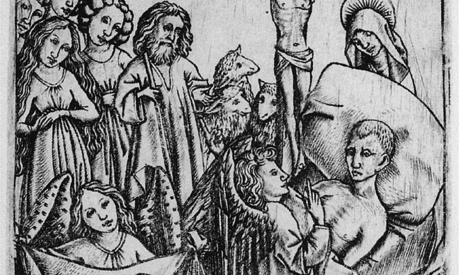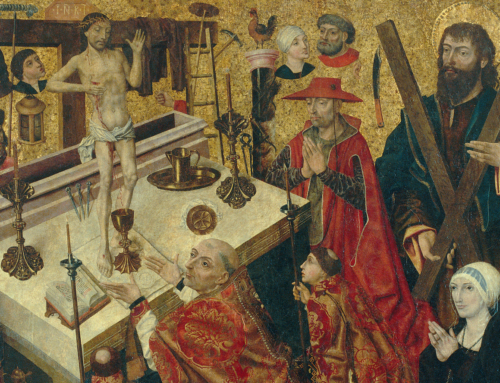Ars Moriendi, or “The Art of Dying,” was an immensely popular and influential medieval text aimed at equipping the faithful for death and dying. It appeared by order of the Council of Constance sometime between 1414 and 1418, and although its author is anonymous, some scholars speculate that it was a Dominican friar.
It is no surprise that the Church would focus on death-related themes at this time: one of the central pastoral preoccupations of the late medieval Church was preparing souls for death, which included saving them from damnation and shortening their stay in purgatory. To suppose that this focus on death was primarily driven by the effects of the bubonic plague is probably an oversimplification; it seems, rather, to be a foundational characteristic of medieval piety, resulting from a flourishing belief in the reality of life after death and the salvific efficacy of the sacraments. Hence, securing the ministrations of a priest in the final hours of death was a chief concern. But the impact of the bubonic plague, including the loss of clergy who would assist the dying, heightened the need for additional forms of guidance—thus arose the Ars Moriendi, a standard for deathbed pastoral practice intended for the use of dying persons and their loved ones assisting them.
The span of centuries notwithstanding, some modern-day bioethicists have looked to the medieval Ars Moriendi for inspiration in discussing contemporary approaches to death and dying. They recognize that patients nearing the end of life today often are overwhelmed by the complexity of health care and miss the opportunity to prepare well for death. A modern-day Ars Moriendi, then, would serve as a corrective to the prevailing over-medicalized, technologically driven death. Whereas bioethicists generally have sought to use the medieval text as inspiration for an approach that accommodates a wide variety of belief systems, religious and secular, it seems vital that the expressed religious intent be preserved in such a work—in fact, certain insights from the medieval text may provide a helpful addition to contemporary pastoral approaches at the end of life.
Just a cursory look at the medieval Ars Moriendi may suffice to draw out some of these insights. As the text emphasizes, dying persons are commonly faced with temptations that threaten to rob them of salvation, including the temptation against faith, the temptation of despair, and the temptation of pride that leads to complacency. When faced with these temptations, such persons must realize the importance of dying in the faith of Christ and in union with the Church to attain salvation, which is true happiness. This includes the reception of the sacraments, repeated professions of faith, self-examinations, and prayer.
For sure, the sacraments are the primary means by which the faithful can attain salvation; nevertheless, one can resist the graces offered in the sacraments, and so these other practices are important to help dispose one to receive the sacraments efficaciously. In this way, simply ensuring the visitation of a priest and the reception of the sacraments does not suffice. While efforts must be made to console dying persons that death itself is not to be feared, in light of Christ’s salvific act, it is better to stir them from complacency than to allow them to drift away from God for the sake of comfort.
These insights from the medieval Ars Moriendi may be key in reclaiming an art of dying for the twenty-first century. They give cause for concern that the typical approach for Catholics nearing the end of life today presumes that the reception of the sacraments all but guarantees salvation—typically, little emphasis is placed on the need for regular self-examination, professions of faith, and overcoming common temptations against the love of God. Instead, the focus is on consoling the dying person and loved ones, not necessarily for the sake of overcoming fear of death to remove a barrier to salvation, but out of deference to social sensibilities. Based on these concerns, it seems we truly are in need of a modern-day Ars Moriendi. The medieval text makes clear that the reality of judgment after death and hope for the salvation of souls should take priority over everything else, including attempts to better navigate the complexities and limitations of medical management at the end of life.
✠
Image: Master E.S., Trost durch Abwenden vom Irdischen







